 The title of this post is how I imagine Ron Popeil hawking some magic weight loss device on a late night infomercial.
The title of this post is how I imagine Ron Popeil hawking some magic weight loss device on a late night infomercial.
I already have such a device. Well, it’s not really magic and it won’t work for everybody but my smartphone did actually help me lose a few pounds.
First off let me say that I have not tried every weight loss trick in the world.
I have, in fact, tried almost none. I’ve weighed far too much for far too long but sugar and cholesterol and other levels have been fine so my doctor hasn’t beaten me up about it. I didn’t, and still don’t, beat myself up about it either even though I wasn’t happy about it. Every now and then I might scan an article on weight loss but they tend to be about various diets to follow, groups to join, or people to pay to tell you what to eat. Then, somewhere along the way, I saw an article claiming that simply tracking consumption was one of the most effective aids to losing weight and that clicked with the geek buried — ever deeper — inside me.
In my head, I somehow managed to relate computerized calorie counting with Quicken. I’ve been a Quicken user since about 1994. Entering numbers into a computer program felt natural to me and sometimes even fun. I’ve never used Quicken’s budget management features though I’ve no doubt they are wonderful. Simply tracking my money helped me get most of my bills paid on time and allowed me to see when a tight spot was approaching. That “tracking helps lose weight” claim seemed perfectly legit to me.
That getting my phone involved made sense was no doubt due in part to a recent addition I’d made to my money tools. I try to track cash expenditures but I’m not terribly good at it and have learned to accept a fair sized miscellaneous expense at the end of each month. Not long ago I installed a free app, Cash2QIF, that lets me enter the cost of my breakfast while I’m still sipping coffee then electronically transfer the data to Quicken later. The miscellaneous expenses have not gone to zero but they’re smaller. Entering calories at the same time seemed like something that might work.
So I picked up a free “calorie counter” app and set out to track what I ate. In hindsight, it’s pretty obvious to me that things would have fallen apart rather quickly if, as was my assumption, I really had to determine and enter a bunch of numeric values. Fortunately the app provided access to a database of foods so it was easy to determine the calories in the three 16 ounce glasses of carrot juice I was drinking everyday. Just kidding. Carrot juice can indeed be found (I just checked) but so can things like Smithwick’s and half pound ‘burgers. Find the food, tap to enter, and the appropriate calories are recorded along with other nutritional data like fat, carbs, vitamins, etc.
Even better is the app’s use of the phone’s camera to read bar codes. As a kitchen challenged single male, I eat a goodly amount of packaged foods. With dinner in the microwave, I can point the phone at the package before pitching it and the calories, carbs, and calcium I am about to consume are instantly recorded. I also eat out a lot and menu items from many restaurants are available in the database.
My rate of reduction is a long way from remarkable. Twenty-two pounds in twenty-weeks. Barely a pound a week. A friend who went on a low-carb diet a while after I started recording calories has lost more than twice that in less time. I like his results but I’m pretty sure I wouldn’t stick to that or any other real diet. I haven’t really cut out anything in particular. I have a target number of calories per day. I don’t panic if I miss it but I’m aware of it and try to do better the next day or the next one or the one after that. Most, but not all, weekly totals have been below the target.
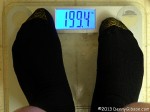 The number on that scale is significant for a couple of reasons. First off, I think it may be the first time I’ve been below 200 this century. Secondly, it’s near a halfway point of sorts. The most generous of guidelines puts my “ideal weight” around 175 pounds. When I started counting calories on January 19, I was 47 over. Half of 47 is 23.5 and the 22 pounds that I’ve lost is within a large smidgen of that. I don’t know that I’ll ever make it to that “ideal” but it no longer seems completely impossible.
The number on that scale is significant for a couple of reasons. First off, I think it may be the first time I’ve been below 200 this century. Secondly, it’s near a halfway point of sorts. The most generous of guidelines puts my “ideal weight” around 175 pounds. When I started counting calories on January 19, I was 47 over. Half of 47 is 23.5 and the 22 pounds that I’ve lost is within a large smidgen of that. I don’t know that I’ll ever make it to that “ideal” but it no longer seems completely impossible.
The app I’m using is the Android version of MyFitnessPal. I didn’t do much research so I don’t know that it’s the best available. I do know that it has the features I was looking for plus some I wasn’t but which have proven key to my continued use. It also has features, such as counting vitamins and connecting to scales, armbands, and other devices, that I doubt I’ll ever use.
A significant boundary was crossed about halfway between the two pictures. During the middle of some night in April, I went from being officially obese to being officially overweight. Yeah, that’s a lot like learning that your checking account isn’t overdrawn as much this month as last but I’ll take it.
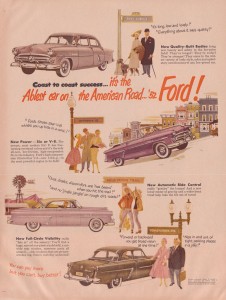 The fellow who drove my Mercury in that demolition derby was named Terry. He lived in the same town as my grandparents and had been a frequent passenger on the J. C. Higgins bicycle with the pseudo-fins on the carrier. When we got a little older, I was a frequent passenger on the back of his Zundapp motorcycle and we were both frequent passengers in each other’s cars. In Terry’s case that was a 1952 Ford.
The fellow who drove my Mercury in that demolition derby was named Terry. He lived in the same town as my grandparents and had been a frequent passenger on the J. C. Higgins bicycle with the pseudo-fins on the carrier. When we got a little older, I was a frequent passenger on the back of his Zundapp motorcycle and we were both frequent passengers in each other’s cars. In Terry’s case that was a 1952 Ford. Imagine the car in this picture with dark blue paint and baby moon hub caps and you’ll have something close to what I was driving in the spring of 1965. Besides two doors, it had dual two-barrels on an Offenhauser manifold, dual points in a Mallory distributor, and dual exhausts. It wasn’t particularly fast by 1965 standards but its description sounded fast.
Imagine the car in this picture with dark blue paint and baby moon hub caps and you’ll have something close to what I was driving in the spring of 1965. Besides two doors, it had dual two-barrels on an Offenhauser manifold, dual points in a Mallory distributor, and dual exhausts. It wasn’t particularly fast by 1965 standards but its description sounded fast.

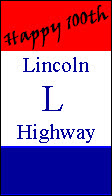
 I am not someone who delights in using old film cameras. I can appreciate that others do and I can appreciate the phenomenal engineering and manufacturing accomplishments embodied in high-end film cameras. But I like the convenience and economy of digital photography far too much to spend my own time and money on anything else — with one exception.
I am not someone who delights in using old film cameras. I can appreciate that others do and I can appreciate the phenomenal engineering and manufacturing accomplishments embodied in high-end film cameras. But I like the convenience and economy of digital photography far too much to spend my own time and money on anything else — with one exception.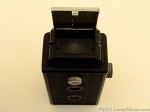
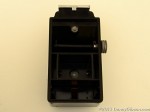



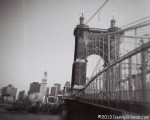

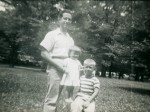


 I didn’t need this camera. My three year old D40 was working just fine and was all the camera I really needed. But, while facts and logic may have slowed me down, they didn’t stop me. Although I can’t entirely deny the attraction of more pixels, that was not the the primary or even secondary reason I wanted this camera. The main attraction was the supposed superiority of the D5100’s CMOS sensor over the D40’s CCD. Secondly, I desired vibration reduction (VR) lenses. Yes, I could have simply bought VR lenses without the camera but I had convinced myself that putting money into lenses then attaching them to the lowly D40 was not wise. As I said, facts and logic only slow me down.
I didn’t need this camera. My three year old D40 was working just fine and was all the camera I really needed. But, while facts and logic may have slowed me down, they didn’t stop me. Although I can’t entirely deny the attraction of more pixels, that was not the the primary or even secondary reason I wanted this camera. The main attraction was the supposed superiority of the D5100’s CMOS sensor over the D40’s CCD. Secondly, I desired vibration reduction (VR) lenses. Yes, I could have simply bought VR lenses without the camera but I had convinced myself that putting money into lenses then attaching them to the lowly D40 was not wise. As I said, facts and logic only slow me down.